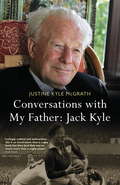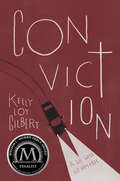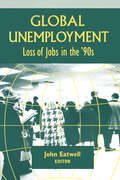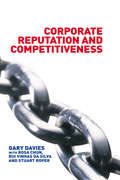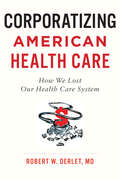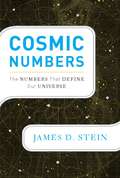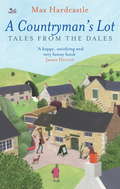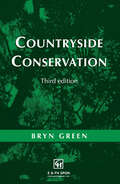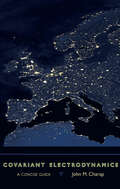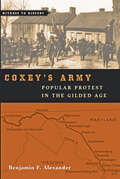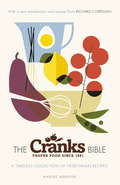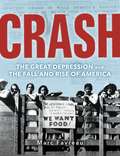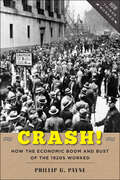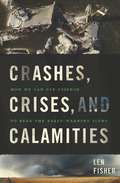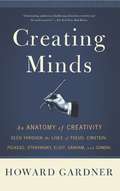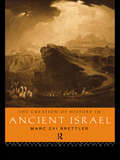- Table View
- List View
Conversations with My Father: Jack Kyle
by Justine Kyle McGrathJack Kyle was the rugby giant of his time, but he was also so much more than a sporting legend.Whilst he was winning a Grand Slam and touring with the Lions, Jack Kyle was also studying to be a doctor. When he retired from playing rugby - as the world's most-capped player - his sense of adventure and medical ambition led him to settle in Chingola, Zambia, where he spent the next thirty-four years of his life. For many years, he was the only medically trained surgeon in the town and so faced many challenges, not least the appearance of and devastation caused by AIDS.Written as a series of conversations with his daughter, Justine, Conversations with My Father reveals Jack Kyle as a supremely gifted rugby player, a dedicated surgeon and a gentle family man.
Conviction
by Kelly Loy GilbertA teenage boy faces an impossible choice in this brutally honest debut novel about family, faith, and the ultimate test of conviction, that was the winner of the Children's Choice Book Awards' Teen Choice Debut Author Award.Ten years ago, Braden was given a sign—a promise that his family wouldn't fall apart the way he feared. But Braden got it wrong: his older brother, Trey, has been estranged from the family for almost as long, and his father, the only parent Braden has ever known, has been accused of murder. The arrest of Braden's father, a well-known Christian radio host, has sparked national media attention. His fate lies in his son's hands; Braden is the key witness in his father's upcoming trial.Braden has always measured himself through baseball. He is the star pitcher in his small town of Ornette, and his ninety-four mile per hour pitch already has minor league scouts buzzing in his junior year. Now the rules of the sport that has always been Braden's saving grace are blurred in ways he never realized, and the prospect of playing against Alex Reyes, the nephew of the police officer his father is accused of killing, is haunting his every pitch.
Cook with Amber: Fun, Fresh Recipes to Get You in the Kitchen
by Amber Kelley"Amber's beautiful book is bursting with great ideas that make healthy eating a joy-and she's done a great job covering all the bases that, in my experience, teens and kids really want." -- Jamie Oliver Fifteen-year-old Amber Kelley is inspiring a whole new generation of eaters to get in the kitchen and have fun. She is the first winner of Food Network Star Kids, a member of celebrity chef Jamie Oliver's Food Tube family, and the host of her own web series on Foodnetwork.com and YouTube. Her work has been recognized by First Lady Michelle Obama, and Amber has been featured on national TV networks such as the Disney Channel, E!, and NBC's Today. Now, Amber's 80 most popular and delicious recipes have been hand-picked for her cookbook to empower teens to get in the kitchen. From nourishing breakfasts to start the day right, to school lunches to impress your friends, party ideas for every occasion, and even recipes for the best homemade facial scrubs to fight that dreaded teen acne, Amber shares her secrets for using the power of food to get the best out of her teen years. Includes 45 full-color photographs throughout.
The Cook's Tale: Life below stairs as it really was
by Tom Quinn Nancy JackmanNancy Jackman was born in 1907 in a remote Norfolk village. Her father was a ploughman, her mother a former servant who struggled to make ends meet in a cottage so small that access to the single upstairs room was via a ladder. The pace of life in that long-vanished world was dictated by the slow, heavy tread of the farm horse and though Nancy's earliest memories were of a green, sunny countryside still unspoiled by the motorcar, she also knew at first hand the harshness of a world where the elderly were forced to break stones on the roads and where school children were regularly beaten. Nancy left school at the age of twelve to work for a local farmer who forced her to stand in the rain when she made a mistake, physically abused her and eventually tried to rape her. Nancy continued to work as a cook until the 1950s, sustained by her determination to escape and find a life of her own.
Coping with Global Unemployment: Putting People Back to Work
by John EatwellA collection of papers that address unemployment as a social phenomenon. It suggests there are solutions if society is willing to take the steps necessary to find and implement them. Focus is on the persistent unemployment in the USA and the UK.
Corporate Assessment: Auditing a Company's Personality (Routledge Revivals)
by Adrian Furnham Barrie GunterCorporate Assessment, first published in 1993, looks at four types of company audit and provides a pragmatic, readable guide for managers. The authors show how assessment of a company in terms of its culture, climate, communications and customers can enhance management vision and lead to recommendations designed to improve employee satisfaction, motivation, loyalty and performance. Insight is provided into the kinds of measurement tools and assessment techniques that are available, and the authors offer recommendations for the use of these instruments, and how best to utilize the information they can produce. This book will not only be of interest to managers who need to assess their companies, but to students of business, organizational psychology, and human resource management.
Corporate Reputation and Competitiveness
by Rosa Chun Rui Da Silva Gary Davies Stuart RoperThis unique book written by four world leaders in reputation research, presents the latest cutting-edge thinking on organizational improvement. It covers media management, crisis management, the use of logos and other aspects of corporate identity, and argues the case for reputation management as a way of overseeing long-term organizational strategy. It presents a new approach to managing reputation, one that relies on surveying customers and employees on their view of the corporate character and in harmonizing the values of both. This approach has been trialled in a number of organizations and here the authors demonstrate how improving reputation, merely by learning more about what a company is already doing, is worth some five per cent sales growth. The book is a vital, up to date resource for specialists in corporate communication, public relations, marketing, HRM, and business strategy as well as for all senior management. Highly illustrated with over eighty diagrams and tables, it includes up to the minute illustrative case studies and interviews with leading authorities in the field.
Corporatizing American Health Care: How We Lost Our Health Care System
by Robert W. DerletOver the past three decades, the once-efficient American health care system has evolved into a complex maze of monopolies and a racket of bureaucratic checks, approvals, denials, roadblocks, and detours. This shift has created a massive and at times redundant workforce that frustrates patients, as well as physicians, nurses, and administrative staff. Health care costs the United States over $3 trillion each year and consumes over 18% of the country's gross domestic product. That's more than $11,000 for each person in the country each year—more than double what it costs in most Western European countries to deliver equal or even better care.In Corporatizing American Health Care, Robert W. Derlet, MD, traces the progression of health care policy in the United States. How, he asks, has US health care transformed from bedside medicine—a model of small practices and patient-focused care—into corporate medicine, which prioritizes profit and deals with both patient care and outcomes as billing codes? Arguing that the US Congress is the root of the problem, he describes how Congress has failed to enact legislation to prevent corporate monopolies in the health care industry. Instead, corrupted by large campaign donations and corporate lobbyists, Congress has crafted loopholes benefiting corporations and harming people. Drawing on his decades as a practicing physician caring for thousands of patients, as well as his university and medical school teaching experience, Derlet follows changes to both policy and practice across many sectors of health care. Scrutinizing how hospitals work, he also takes a hard look at high prescription drug prices, unresponsive insurance companies, problems with the Affordable Care Act, the growing medical implant device industry, and even nursing homes. Finally, he explains why the dominance of corporations and their lobbyists over health policy means that we now pay more for our care and our medications but have less choice both in what doctors we see and in what drugs we take. Breaking down the complex ABCs of health care to reveal the unscrupulous practices of the health care industry, Corporatizing American Health Care is perfect for both students and general readers who want to understand the changes in our system from the perspective of an actual doctor.
Corporatizing American Health Care: How We Lost Our Health Care System
by Robert W. DerletOver the past three decades, the once-efficient American health care system has evolved into a complex maze of monopolies and a racket of bureaucratic checks, approvals, denials, roadblocks, and detours. This shift has created a massive and at times redundant workforce that frustrates patients, as well as physicians, nurses, and administrative staff. Health care costs the United States over $3 trillion each year and consumes over 18% of the country's gross domestic product. That's more than $11,000 for each person in the country each year—more than double what it costs in most Western European countries to deliver equal or even better care.In Corporatizing American Health Care, Robert W. Derlet, MD, traces the progression of health care policy in the United States. How, he asks, has US health care transformed from bedside medicine—a model of small practices and patient-focused care—into corporate medicine, which prioritizes profit and deals with both patient care and outcomes as billing codes? Arguing that the US Congress is the root of the problem, he describes how Congress has failed to enact legislation to prevent corporate monopolies in the health care industry. Instead, corrupted by large campaign donations and corporate lobbyists, Congress has crafted loopholes benefiting corporations and harming people. Drawing on his decades as a practicing physician caring for thousands of patients, as well as his university and medical school teaching experience, Derlet follows changes to both policy and practice across many sectors of health care. Scrutinizing how hospitals work, he also takes a hard look at high prescription drug prices, unresponsive insurance companies, problems with the Affordable Care Act, the growing medical implant device industry, and even nursing homes. Finally, he explains why the dominance of corporations and their lobbyists over health policy means that we now pay more for our care and our medications but have less choice both in what doctors we see and in what drugs we take. Breaking down the complex ABCs of health care to reveal the unscrupulous practices of the health care industry, Corporatizing American Health Care is perfect for both students and general readers who want to understand the changes in our system from the perspective of an actual doctor.
Cosmic Numbers: The Numbers That Define Our Universe
by James D. SteinOur fascination with numbers begins when we are children and continues throughout our lives. We start counting our fingers and toes and end up balancing checkbooks and calculating risk. So powerful is the appeal of numbers that many people ascribe to them a mystical significance. Other numbers go beyond the supernatural, working to explain our universe and how it behaves. In Cosmic Numbers, mathematics professor James D. Stein traces the discovery, evolution, and interrelationships of the numbers that define our world. Everyone knows about the speed of light and absolute zero, but numbers like Boltzmann's constant and the Chandrasekhar limit are not as well known, and they do far more than one might imagine: They tell us how this world began and what the future holds. Much more than a gee-whiz collection of facts and figures, Cosmic Numbers illuminates why particular numbers are so important-both to the scientist and to the rest of us.
Could It Be Forever? My Story: My Story
by David CassidyThis ebook edition contains the full text version as per the book. Doesn't include original photographic and illustrated material. In the seventies, when he was just 20 years old, David Cassidy achieved the sort of teen idol fame that is rarely seen. He was mobbed everywhere he went. His clothes were regularly ripped off by adoring fans. He sold records the world over. He was bigger than Elvis. And all thanks to a hit TV show called The Partridge Family. Now, in his own words, this is a brutally frank account of those mindblowing days of stardom in which being David Cassidy played second fiddle to being Keith Partridge. Including stories of sex, drugs and rock'n'roll that explode the myth of Cassidy as squeaky clean, it's also the story of how to keep on living life and loving yourself when the fickle fans fall away.
Counterworks: Managing the Diversity of Knowledge (ASA Decennial Conference Series: The Uses of Knowledge)
by Richard FardonGlobalization is often described as the spread of western culture to other parts of the world. How accurate is the depiction of 'cultural flow'? In Counterworks, ten anthropologists examine the ways in which global processes have affected particular localities where they have carried out research. They challenge the validity of anthropological concepts of culture in the light of the pervasive connections which exist between local and global factors everywhere.Rather than assuming that the world is culturally diverse, this book proposes that culture is itself a representation of the similarities and difference recognized between forms of social life. The authors address issues of globalization in terms of diverse histories and traditions of knowledge, which may include the construction of difference as cultural.In its attention to specific local situations, such as Bali, Cuba, Bolivia, Greece, Kenya, and the Maoris in New Zealand, Counterworks argues that the apparent oppositoin between strong westernizing, global forces and weak concept of culture, which supposes cultures to be integrated and possessed of essential properties, needs rethinking in a contemporary world where a marked sense of culture has become a wide-spread property of people's social knowledge.The book will have wide appeal to anthropologists, to students of comparative studies in history, religion and language, and to anyone interested in the phenomenon of postmodernism.
A Countryman's Lot: Tales From The Dales
by Max HardcastleMax and Vicky Hardcastle have a daydream . . .One day, they'll sell their cramped city-centre antiques shop and the overflowing upstairs flat and relocate to the beautiful Yorkshire Dales. If they could only find the perfect place to house both family and business, then that fantasy might become a reality. . . When a smallholding in a remote Dales village comes on the market, it seems like the answer to their prayers. Bullpen Farm might need 'some renovation', but it has an orchard, outbuildings and all the charm they've dreamt of. Before long, the Hardcastles find themselves the proud owners of a collection of ramshackle buildings and the newest members of a close-knit community which seems to have more than its fair share of eccentrics.From the antics of the antiques trade to the uproarious incidents of village life, it turns out that rural living isn't quite as tranquil as they'd imagined!'A happy, satisfying and very funny book' James Herriot
Countryside Conservation: Land Ecology, Planning and Management
by Bryn GreenThis third edition of the standard text Countryside Conservation charts and evaluates those changes which represent a fundamental revolution in the ways in which the countryside is planned and managed. It sets out the principles, policies and practice which underlie the ecology, planning and management of the new countryside, discussing ways in which countryside conservation objectives are evolving and how they can best be achieved.
The Courtesan's Lover
by Gabrielle KimmFrancesca Felizzi, former mistress of the Duke of Ferrara, is now an aspiring courtesan. Astonishingly beautiful and ambitious, she revels in the power she wields over men.But when she is visited by an inexperienced young man, it becomes horribly clear to Francesca that despite her many admiring patrons, she has never truly been loved. Suddenly, her glittering and sumptuous life becomes a gaudy façade. And then another unexpected encounter brings with it devastating implications that plunge Francesca and her two young daughters into the sort of danger she has dreaded ever since she began to work the streets all those years ago.
Covariant Electrodynamics: A Concise Guide
by John M. CharapA notoriously difficult subject, covariant electrodynamics is nonetheless vital for understanding relativistic field theory. John M. Charap’s classroom-tested introduction to the mathematical foundations of the topic presents the material in an approachable manner.Charap begins with a historical overview of electrodynamics and a discussion of the preliminary mathematics one needs in order to grasp the advanced and abstract concepts underlying the theory. He walks the reader through Maxwell’s four equations, explaining how they were developed and demonstrating how they are applied. From there, Charap moves through the other components of electrodynamics, such as Lorentz transformations, tensors, and charged particle behavior. At each point, he carefully works through the mathematics, applies the concepts to simple physical systems, and provides historical context that makes clear the connections among the theories and the mathematicians responsible for developing them. A concluding chapter reviews the history of electrodynamics and points the way for independent testing of the theory.Thorough, evenly paced, and intuitive, this friendly introduction to high-level covariant electrodynamics is a handy and helpful addition to any physicist’s toolkit.
Covariant Electrodynamics: A Concise Guide
by John M. CharapA notoriously difficult subject, covariant electrodynamics is nonetheless vital for understanding relativistic field theory. John M. Charap’s classroom-tested introduction to the mathematical foundations of the topic presents the material in an approachable manner.Charap begins with a historical overview of electrodynamics and a discussion of the preliminary mathematics one needs in order to grasp the advanced and abstract concepts underlying the theory. He walks the reader through Maxwell’s four equations, explaining how they were developed and demonstrating how they are applied. From there, Charap moves through the other components of electrodynamics, such as Lorentz transformations, tensors, and charged particle behavior. At each point, he carefully works through the mathematics, applies the concepts to simple physical systems, and provides historical context that makes clear the connections among the theories and the mathematicians responsible for developing them. A concluding chapter reviews the history of electrodynamics and points the way for independent testing of the theory.Thorough, evenly paced, and intuitive, this friendly introduction to high-level covariant electrodynamics is a handy and helpful addition to any physicist’s toolkit.
The Covenant of Genesis: A Novel (Wilde/Chase #4)
by Andy McDermottIn the brilliant fourth book from Andy McDermott, Nina Wilde must battle the Covenant of Genesis if she is to find the world’s greatest archaeological treasure...Off the coast of Indonesia, archaeologist Nina Wilde makes an explosive find: evidence of a settlement that existed over a hundred thousand years before any previously known civilisation. But when her ship is attacked, it becomes clear that the clandestine religious group calling itself the Covenant of Genesis will stop at nothing to prevent her from revealing this knowledge.With her fiancé Eddie Chase, Nina embarks upon a dangerous worldwide search to expose the Covenant of Genesis – and the incredible secret they will kill to conceal.
Coxey's Army: Popular Protest in the Gilded Age (Witness to History)
by Benjamin F. AlexanderIn 1893, after a major British bank failure, a run on U.S. gold reserves, and a late-June stock-market crash, America was in the throes of a serious economic depression. Unemployment rose, foreclosures climbed, and popular unrest mounted. By the following spring, businessman and Populist agitator Jacob S. Coxey was fed up with government inactivity in the face of the crisis. With the help of eccentric showman Carl Browne, he led a group of several hundred unemployed wage earners, small farmers, and crossroads merchants on a march from Massillon, Ohio, to Washington, D.C., to present a "petition in boots" for government-financed jobs building and repairing the nation’s roads. On May 1, the Coxeyites descended on the center of government, where Coxey attempted to deliver a speech on the Capitol steps. The police attacked, a melee ensued, and Coxey and Browne spent a month in jail. Meanwhile, other Coxey-inspired contingents were on their way east from places as far away as San Francisco and Portland. Some of them even hijacked trains along the way. Who was Coxey, and what motivated himâ€�along with the angry marchers who joined his cause? What did other Americans think of the protesters? Was there ever any chance that the protesters’ demands would be met? Where did the agitators fit in with the politics of their day, and how did their actions jibe with the other labor-related protests happening that year? In this concise and gripping narrative, Benjamin F. Alexander contextualizes the march by vividly describing the misery wrought by the Panic of ’93. Alexander brings both Coxey and his fellow leaders to life, along with the reporters and spies who traveled with them and the diverse group of captivated newspaper readers who followed the progress of the marches and train heists.Coxey’s Army explains how the demands of the Coxeyitesâ€�far from being the wild schemes of a small group of cranksâ€�fit into a larger history of economic theories that received serious attention long before and long after the Coxey march. Despite running a gauntlet of ridicule, the marchers laid down a rough outline of what, some forty years later, emerged as the New Deal.
The Cranks Bible: A Timeless Collection of Vegetarian Recipes
by Nadine AbensurA classic collection of healthy and delicious plant-based recipes from the Cranks kitchenSince opening their first restaurant in 1961, Cranks have been pioneers of vegetarian cuisine and champions of organic produce. Here, celebrated writer and chef Nadine Abensur presents over 200 classic meat-free recipes from the Cranks kitchen. From pumpkin and parsley risotto to aubergines with smoked ricotta, passion fruit ice-cream, walnut and raisin loaves and plum jam, every recipe is packed full of beautifully simple, natural ingredients that will nourish both body and soul. With advice on selecting the freshest seasonal produce, eating healthily and enjoying the experience of making mouth-watering food, THE CRANKS BIBLE is a celebration of vegetarian cooking and an essential resource for every home.
Crash: The Great Depression and the Fall and Rise of America
by Marc FavreauThe incredible true story of how real people weathered one of the most turbulent periods in American history—the Great Depression—and emerged triumphant. From the sweeping consequences of the stock market crash to the riveting stories of individuals and communities caught up in a real American dystopia, discover how the country we live in today was built in response to a time when people from all walks of life fell victim to poverty, insecurity, and fear. Meet fascinating historical characters like Herbert Hoover, Franklin Delano and Eleanor Roosevelt, Frances Perkins, Dorothea Lange, Walter White, and Mary McLeod Bethune. See what life was like for regular Americans as the country went from the highs of the Roaring Twenties to the lows of the Great Depression, before bouncing back again during World War II. Explore pivotal scenes such as the creation of the New Deal, life in the Dust Bowl, the sit-down strikes in Michigan, the Scottsboro case, and the rise of Father Coughlin. Packed with photographs and firsthand accounts, and written with a keen understanding of the upheaval of the 1930s, Crash shares the incredible story of how America survived—and, ultimately, thrived.
Crash!: How the Economic Boom and Bust of the 1920s Worked (How Things Worked)
by Phillip G. PayneSpeculation�an economic reality for centuries�is a hallmark of the modern U.S. economy. But how does speculation work? Is it really caused, as some insist, by popular delusions and the madness of crowds, or do failed regulations play a greater part? And why is it that investors never seem to learn the lessons of past speculative bubbles? Crash! explores these questions by examining the rise and fall of the American economy in the 1920s.Phillip G. Payne frames the story of the 1929 stock market crash within the booming New Era economy of the 1920s and the bust of the Great Depression. Taking into account the emotional drivers of the consumer market, he offers a clear, concise explanation of speculation's complex role in creating one of the greatest financial panics in U. S. history.Crash! explains how postWorld War I changes in the global financial markets transformed the world economy, examines the role of boosters and politicians in promoting speculation, and describes in detail the disastrous aftermath of the 1929 panic. Payne's book will help students recognize the telltale signs of bubbles and busts, so that they may become savvier consumers and investors.
Crashes, Crises, and Calamities: How We Can Use Science to Read the Early-Warning Signs
by Len FisherWhy do certain civilizations, societies, and ecosystems collapse? How does the domino effect relate to the credit crunch? When can mathematics help explain marriage? And how on earth do toads predict earthquakes? The future is uncertain. But science can help foretell what lies ahead.Drawing on ecology and biology, math and physics, Crashes, Crises, and Calamities offers four fundamental tools that scientists and engineers use to forecast the likelihood of sudden change: stability, catastrophe, complexity, and game theories. In accessible prose, Len Fisher demonstrates how we can foresee and manage events that might otherwise catch us by surprise.At the cutting edge of science, Fisher helps us find ways to act before a full-fledged catastrophe is upon us. Crashes, Crises, and Calamities is a witty and informative exploration of the chaos, complexity, and patterns of our daily lives.
Creating Minds: An Anatomy of Creativity as Seen Through the Lives of Freud, Einstein, Picasso, Stravinsky, Eliot, G
by Howard E. GardnerThis peerless classic guide to the creative self uses portraits of seven extraordinary individuals to reveal the patterns that drive the creative process -- to demonstrate how circumstance also plays an indispensable role in creative success.Howard Gardner changed the way the world thinks about intelligence. In his classic work Frames of Mind, he undermined the common notion that intelligence is a single capacity that every human being possesses to a greater or lesser extent. With Creating Minds, Gardner gives us a path breaking view of creativity, along with riveting portraits of seven figures who each reinvented an area of human endeavor. Using as a point of departure his concept of seven "intelligences," ranging from musical intelligence to the intelligence involved in understanding oneself, Gardner examines seven extraordinary individuals -- Sigmund Freud, Albert Einstein, Pablo Picasso, Igor Stravinsky, T.S. Eliot, Martha Graham, and Mahatma Gandhi -- each an outstanding exemplar of one kind of intelligence. Understanding the nature of their disparate creative breakthroughs not only sheds light on their achievements but also helps to elucidate the "modern era" -- the times that formed these creators and which they in turn helped to define. While focusing on the moment of each creator's most significant breakthrough, Gardner discovers patterns crucial to our understanding of the creative process. Creative people feature unusual combinations of intelligence and personality, and Gardner delineates the indispensable role of the circumstances in which an individual's creativity can thrive -- and how extraordinary creativity almost always carries with it extraordinary human costs.
The Creation of History in Ancient Israel
by Marc Zvi BrettlerThe Creation of History in Ancient Israel demonstrates how the historian can start to piece together the history of ancient Israel using the Hebrew Bible as a source.
